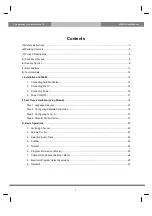
7
Circuit Description
Receive Signal Path
Narrow FM and AM mode
Incoming RF from the antenna jack is passed through a
low-pass filter and high-pass filter consisting of coils
L1028, L1030, L1035, and L1036, capacitors C1142, C1147,
C1153, C1155, C1159, C1164, C1167, C1177, and C1221 and
antenna switching diodes
D1019
(
RLS135
),
D1020
(
RN739F
), and
D1023
(
DAN235U
), and then proceeds to
the receiver front end section.
Signals within the frequency range of the transceiver are
applied to the receiver front end which contains RF am-
plifier
Q1043
(
2SC5555
) and a varactor-tuned band-pass
filter consisting of coils L1022, L1023, L1026, L1027, L1037,
L1038, L1043, and L1044, capacitors C1130, C1134, C1135,
C1140, C1143, C1157, C1168, C1175, C1176, C1179, and
C1181, and diodes
D1014
,
D1018
,
D1024
, and
D1026
(all
HVC350
), and then applied to the 1st mixer
Q1040
(
2SC5555
).
Buffered output from the VCO
Q1014
(
2SC5555
) is am-
plified by
Q1017
(
2SC5555
) to provide a pure 1st local
signal between 143.4 and 199.4 MHz for injection to the
1st mixer
Q1040
. The 35.4 MHz 1st mixer product then
passes through monolithic crystal filter
XF1001
(
35M15A1
,
7.5 kHz BW) which strips away unwanted mixer prod-
uct;, the 1st IF signal is then amplified by mixer post-amp
Q1033
(
2SC4215Y
).
The amplified 1st IF signal is applied to the FM IF sub-
system IC
Q2039
(
TK10931V
), which contains the 2nd mix-
er, 2nd local oscillator, limiter amplifier, noise amplifier
and FM detector.
The 2nd local signal is generated by 17.475 MHz PLL ref-
erence/2nd local oscillator
X2001
(
GS4613
). The
17.475MHz signal is doubled by
Q2036
(
2SC4400
) to pro-
duce the 450 kHz 2nd IF when mixed with the 1st IF sig-
nal within
Q2039
. The 2nd IF signal then passes through
the ceramic filter
CF2002
(
ALFYM450
)
and
CF2003
(
CFWM450D
) to remove all but the desired signal.
In the FM mode, the 2nd IF signal from ceramic filters
CF2002
and
CF2003
is applied to the limiter amplifier sec-
tion of
Q2039
, which removes amplitude variations in the
450 kHz IF before detection of the speech by the ceramic
discriminator
CD2001
(
CDBM450C24
). Detected audio
from
Q2039
is passed through the buffer amplifier
Q2045
(
NJM2125F
), de-emphasis network R2101/C2077, AF
switch
Q2022
(
HN1J02FU
), and high-pass filter
Q2020-2
(
NJM2904V
). The processed audio signal from
Q2020-2
passes through the AF MUTE gate
Q2014
(
DTC143ZE
)
and the volume control to the audio power amplifier
Q2010
(
TDA7233D
), providing up to 0.4 Watts to the head-
phone jack or 8
Ω
loudspeaker.
In the AM mode, detected audio from
Q2039
is passed
through the audio amplifier
Q2020-1
(
NJM2904V
) and
ANL circuit, then applied to the AF amplifier
Q2020-2
(
NJM2904V
). When impulse noise is received, a portion
of the AM detector output signal from
Q2039
, including
pulse noise, is rectified by
D2012
(
BAS316
). The result-
ing DC is applied to the ANL MUTE gate
Q1019
(
UMG2N
),
which briefly interrupts the signal flow, thus reducing the
level of the pulse noise.
The processed audio signal from
Q2020-2
passes through
the AF MUTE gate
Q2014
(
DTC143ZE
) and the volume
control to the audio power amplifier
Q2010
(
TDA7233D
),
providing up to 0.4 Watts to the headphone jack or 8
Ω
loudspeaker.
A portion of the AF signal from the FM IF subsystem
Q2039
converted into DC voltage by
D2017
(
BAS316
),
and then passes through the AGC amplifier
Q2026
(
UMW1
) and
Q2027
(
2SA1602A
) to the inversion ampli-
fiers
Q1035
and
Q1042
(both
2SC5555
). These amplifier
reduce the amplifier gain of the IF amplifier
Q1033
and
the RF amplifier
Q1043
when receiving a strong signal.
Wide FM mode
Incoming RF from the antenna jack is passed through a
low-pass filter and high-pass filter consisting of coils
L1028, L1030, L1035, and L1036, capacitors C1142, C1147,
C1153, C1155, C1159, C1164, C1167, C1177, and C1221 and
antenna switching diodes
D1019
(
RLS135
),
D1020
(
RN739F
), and
D1023
(
DAN235U
), and then proceeds to
the receiver front end section.
The RF signal is applied to the wide FM receiver front
end which contains RF amplifiers
Q1041
and
Q1046
(both
2SC5555
) and a varactor-tuned band-pass filter consist-
ing of coils L1017, L1018, L1024, L1025, L1033, L1034,
L1039, and L1040, capacitors C1125, C1128, C1129, C1131,
C1136, C1148, C1158, C1162, C1163, and C1169, and di-
odes
D1013
,
D1015
,
D1022
, and
D1025
(all
HVC359
), then
applied to the 1st mixer
Q1039
(
2SC5555
).
Buffered output from the VCO
Q1014
is amplified by
Q1017
(
2SC5555
) to provide a pure 1st local signal be-
tween 133.68 and 153.65 MHz for injection to the 1st mix-
er. The 45.65 MHz 1st mixer product then passes through
band-pass filter consisting of coils L1010 and L1011, and
capacitors C1075, C1078, C1081, C1083, C1087, and C1093.
The 1st IF signal is applied to the wide FM IF subsystem
IC
Q2023
(
TA7792F
), which contains the 2nd mixer, 2nd
local oscillator, limiter amplifier and FM detector.
The 2nd local signal is generated by 17.475 MHz PLL ref-
erence/2nd local oscillator
X2001
(
GS4613
). The
17.475MHz signal is doubled by
Q2036
(
2SC4400
) to pro-
duce the 10.7 MHz 2nd IF when mixed with the 1st IF
Содержание VXA-710 SPIRIT
Страница 4: ...4 Note ...
Страница 5: ...5 Block Diagram ...
Страница 6: ...6 Connection Diagram ...
Страница 10: ...10 Note ...
Страница 16: ...16 Note ...
Страница 32: ...32 AF Unit Note ...








































